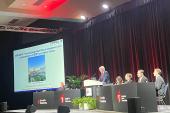Even When Eligible, Not All Acute HF Patients Get GDMT
The Canadian data reflect what’s been seen in other parts of the world, driving home the need for better uptake of proven meds.

Most patients discharged after an acute heart failure (HF) hospitalization are eligible for the four foundational guideline-directed medical therapies (GDMT) for HF with reduced ejection fraction (HFrEF), but prescription rates continue to lag behind, according to a Canadian registry study.
Overall, 71.6% of HFrEF patients in the CAN-HF registry were eligible for all four of the drug classes strongly recommended in international guidelines: angiotensin receptor-neprilysin inhibitors (ARNIs), beta-blockers, mineralocorticoid receptor antagonists (MRAs), and sodium-glucose cotransporter 2 (SGLT2) inhibitors.
Yet over the course of the study, prescription rates for the individual classes were 6.6% for ARNIs, 44.0% for MRAs, and 81.0% for beta-blockers, report Nima Moghaddam, MD (University of British Columbia, Vancouver, Canada), and colleagues. SGLT2 inhibitors were not yet approved for heart failure.
The hope, investigators write this week in JACC: Heart Failure, “is that by presenting these data from a contemporary acute HF population, we can set a framework for clinicians to consider early and rapid prescription of comprehensive HF therapies. Every attempt should be made to initiate GDMT in all eligible patients before discharge, because not prescribing or a delay in prescription exposes patients with HF to a clinically significant excess risk of death and readmission.”
Agreeing was Gregg Fonarow, MD (University of California, Los Angeles), who has researched issues around GDMT use within the Get With The Guidelines – Heart Failure program in the United States.
“This idea that therapy initiation can be deferred to an outpatient [setting] just means condemning that patient to not being treated,” he commented to TCTMD.
Moreover, as senior author Sean Virani, MD (University of British Columbia), told TCTMD, these Canadian data are consistent with prior studies from other parts of the world showing “that there is a large group of undertreated patients based on the available therapies that we have today.”
GDMT Eligibility in the CAN-HF Registry
Recent updates to both the US and European HF guidelines contain strong recommendations to use all four of the drug classes proven to reduce morbidity and mortality in patients with HFrEF. But prior studies have shown that GDMT continues to be underused.
A hospital admission is seen as an opportunity to get patients on the recommended therapies before discharge. That’s important: research has shown that drugs started in the hospital are more likely to be continued when patients transition to the outpatient setting.
To get a handle on what proportion of patients may be eligible for these critical therapies, Moghaddam et al turned to the CAN-HF registry, which enrolled patients hospitalized for acute HF across seven sites in British Columbia, Manitoba, Ontario, and Quebec between January 2017 and April 2020. The analysis included 809 patients with a documented LVEF who were discharged alive—455 (mean age 71.6 years; 69.5% men) had HFrEF, defined as an ejection fraction of 40% or lower, and 354 (mean age 79.3 years; 42.4% men) had HF with preserved ejection fraction (HFpEF), defined as an ejection fraction above that threshold.
Based on approved drug labels, major society guidelines, and/or enrollment criteria from recent key trials, rates of eligibility among patients with HFrEF were as follows:
- 94.9% for beta-blockers
- 88.6% for SGLT2 inhibitors
- 84.4% for MRAs
- 80.7% for ACE inhibitors/ARBs
- 73.6% for ARNIs
- 30.1% for omecamtiv mecarbil
- 25.9% for vericiguat
- 15.6% for ivabradine
Roughly seven out of every 10 patients with HFrEF were deemed eligible for all four of the foundational therapies (beta-blockers, SGLT2 inhibitors, MRAs, and ARNIs), including 75.5% of those with de novo HF and 69.5% with chronic HF.
The investigators also assessed eligibility for some of these medications in patients with HFpEF, finding that 83.1% would be suitable candidates for MRAs, 59.9% for SGLT2 inhibitors, 37.6% for ARNIs, and 38.1% for ACE inhibitors/ARBs.
In general, however, actual prescription rates lagged behind eligibility rates.
Closing the Gaps
Fonarow said this Canadian study reveals substantial treatment gaps when it comes to GDMT for heart failure, similar to what has been seen in other parts of the world, even though he and others have been working for the past two decades on highlighting how hospitalization is an opportune time to start these therapies, which are safe, well tolerated, and effective at improving survival and reducing the risk of rehospitalization.
And the disconnect is not seen only for newer medications, he pointed out. There has been a long-standing class I recommendation for use of MRAs, for instance, and ARNIs have been advised in guidelines for several years. “So these large treatment gaps that we’re seeing extend to medications that have been well established as the standard of care,” noted Fonarow.
This idea that therapy initiation can be deferred to an outpatient [setting] just means condemning that patient to not being treated. Gregg Fonarow
To improve initiation of these proven therapies while patients are still in the hospital, “there needs to be a much greater sense of urgency [and] the recognition of how these patients face a proximate high risk for recurrent worsening of their heart failure, rehospitalization, and death,” Fonarow said. “Just as you would not send a patient out of the hospital after an acute coronary event without antiplatelet therapy, without lipid-lowering therapy, the same mindset is absolutely essential in the patient hospitalized with heart failure.”
Education can play a critical role, he indicated. “There are clinicians that may know that they’re supposed to be utilizing these therapies but get scared off because there is a blood pressure reading or a creatinine reading that should not preclude the use of the therapies but to their perception may limit their use.”
Virani, too, stressed the need for continued knowledge translation to ensure that all clinicians who care for patients with heart failure, and not just cardiologists, are aware of the best practices and know how to apply the data on these therapies to their patients. An update to the Canadian heart failure guideline now underway, and a knowledge translation program that will be implemented through the Canadian Cardiovascular Society, are expected to help in that process.
Moreover, Virani said, systemic barriers related to drug coverage, access to HF specialists, and understanding of and access to diagnostic tests and imaging, need to be removed to allow for optimal prescribing.
Importantly, these issues transcend borders, which “underscores the need for global collaboration of heart failure clinicians, educators, researchers to come up with a considered and consistent approach to this message of making sure that our patients are treated appropriately,” Virani said. “We now have the impetus to say we need a global approach.”
Todd Neale is the Associate News Editor for TCTMD and a Senior Medical Journalist. He got his start in journalism at …
Read Full BioSources
Moghaddam N, Hawkins NM, McKelvie R, et al. Patient eligibility for established and novel guideline-directed medical therapies after acute heart failure hospitalization. J Am Coll Cardiol HF. 2023;Epub ahead of print.
Disclosures
- CAN-HF was funded by Novartis Canada. This study was supported by the Canadian Cardiovascular Institute (CCI-CIC).
- Moghaddam and Virani report no relevant conflicts of interest.





Comments